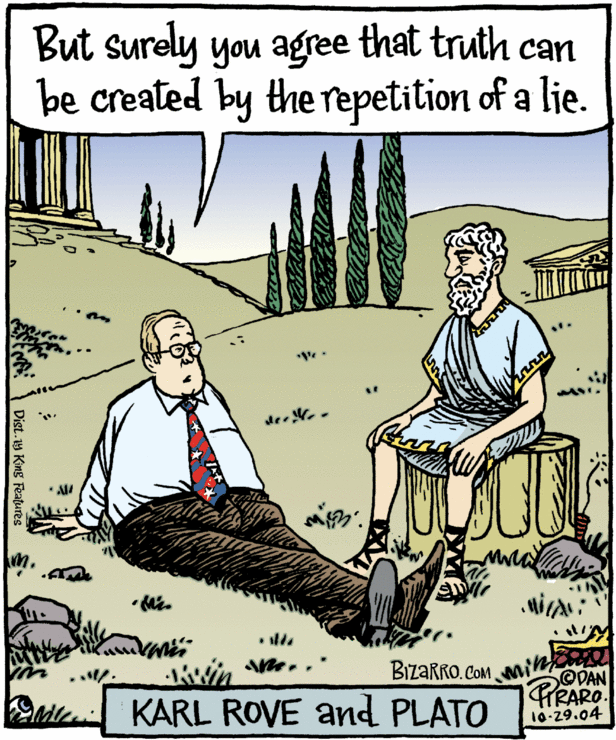“A lie gets halfway around the world before the truth has a chance to get its pants on.” – Winston Churchill*

Courtesy of Dan Piraro – bizarro.com
While most Americans have a wide variety of factual information – literally at their fingertips – when it comes to political tribalism, facts seem to go out the window.
According to a study by the Massachusetts Institute of Technology (MIT) authored by Soroush Vosoughi, Deb Roy and Sinan Aral, human beings, not robots are more likely to spread false information on the internet.
“False claims,” The New York Times reports (Mar. 8), “were 70 percent more likely than the truth to be shared on Twitter. True stories were rarely retweeted by more than 1,000 people, but the top 1 percent of false stories were routinely shared by 1,000 to 100,000 people. And it took true stories about six times as long as false ones to reach 1,500 people.
“ ‘It’s sort of disheartening at first to realize how much we humans are responsible,’ said Sinan Aral, a professor at the M.I.T. Sloan School of Management and an author of the study. ‘It’s not really the robots that are to blame.’ ”
In the study, first published in Science magazine, the authors “examined true and false news stories posted on Twitter from the social network’s founding in 2006 through 2017. The study’s authors tracked 126,000 stories tweeted by roughly three million people more than 4.5 million times. ‘News’ and ‘stories’ were defined broadly — as claims of fact — regardless of the source. And the study explicitly avoided the term ‘fake news,’ which, the authors write, has become ‘irredeemably polarized in our current political and media climate.’ ”
In the study’s abstract, the authors write, “We investigated the differential diffusion of all of the verified true and false news stories distributed on Twitter from 2006 to 2017. The data comprise ~126,000 stories tweeted by ~3 million people more than 4.5 million times. We classified news as true or false using information from six independent fact-checking organizations that exhibited 95 to 98% agreement on the classifications.
“Falsehood diffused significantly farther, faster, deeper, and more broadly than the truth in all categories of information, and the effects were more pronounced for false political news than for false news about terrorism, natural disasters, science, urban legends, or financial information.
“We found that false news was more novel than true news, which suggests that people were more likely to share novel information. Whereas false stories inspired fear, disgust, and surprise in replies, true stories inspired anticipation, sadness, joy, and trust.
“Contrary to conventional wisdom, robots accelerated the spread of true and false news at the same rate, implying that false news spreads more than the truth because humans, not robots, are more likely to spread it.”
“The researchers,” The Times points out, “provided an example of two business stories, and how much more time it took the true one to reach 200 retweets. The example also shows the judgment calls made by fact-checking organizations.
- “In 2014, the fashion chain Zara introduced children’s pajamas with horizontal stripes and a gold star. The company said the design was inspired by what a cowboy sheriff would wear. But Twitter users posted messages saying the pajamas resembled Nazi concentration camp uniforms. Snopes: True. Time to reach 200 retweets: 7.3 hours.
- “In 2016, a website republished a portion of a satirical article about how the Chick-fil-A restaurant chain had decided to begin a “We don’t like blacks either” marketing campaign to stir up controversy and boost sales. It came after the company’s president did say he opposed gay marriage. Snopes: False. Time to 200 retweets: 4.2 hours.”
How do we curb the spread of false news?
“The M.I.T. researchers said that understanding how false news spreads is a first step toward curbing it. They concluded that human behavior plays a large role in explaining the phenomenon, and mention possible interventions, like better labeling, to alter behavior.”
Another, more obvious way; a way that’s been around for decades: critical thinking.
National Geographic magazine offers a guide to the types of questions to ask when receiving new information. Among the key questions to ask:
Who benefits from this? Who is this harmful to?
What is another perspective? What would be the counter-argument?
Where can we get more information? Where will this idea take us?
When would this benefit society? When would this cause a problem?
Why is this a problem or challenge? Why are people influenced by this?
How do we know the truth about this? How does this benefit us or others? How does this harm us or others?
If we are going to make political or cultural judgements that influence our decision-making, we need to check multiple sources. Social media may not be the best source of that information.
If all of us spent a little more time checking sources and examining motives, we might learn to rely on more reputable sources.
*Churchill was not the first to use this quote. According to PaleoFuture, “the oldest version might come from as early as 1787 in a collection of sermons written by the British clergyman Thomas Francklin: ‘Falsehood will fly, as it were, on the wings of the wind, and carry its tales to every corner of the earth; whilst truth lags behind; her steps, though sure, are slow and solemn…’ ”
While Churchill may not have been the first to use a version of the quote, the wisdom behind it remains the same: think more critically when evaluating new information.
Comments










